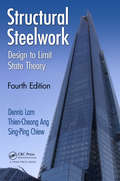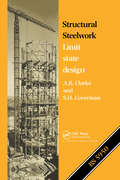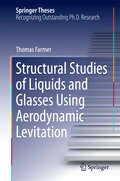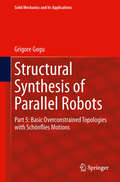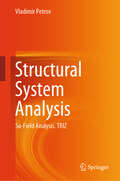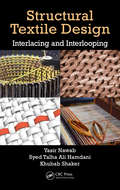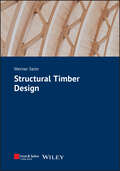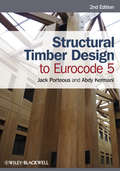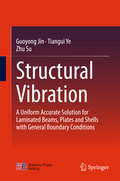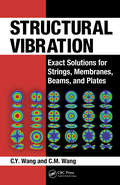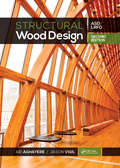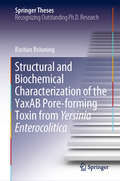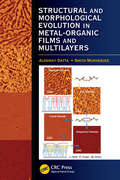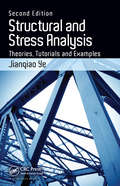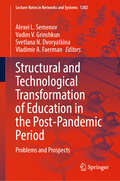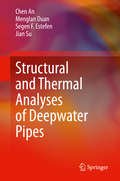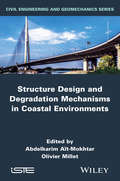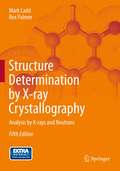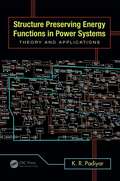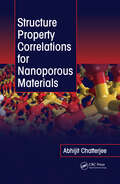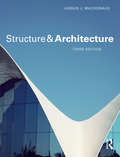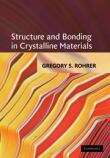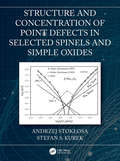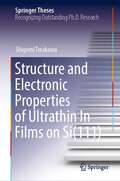- Table View
- List View
Structural Steelwork: Design to Limit State Theory, Fourth Edition
by Dennis Lam Thien Cheong Ang Sing-Ping ChiewCompletely revised and updated, this fourth edition of Structural Steelwork: Design to Limit State Theory describes the design theory and code requirements for common structures, connections, elements, and frames. It provides a comprehensive introduction to structural steelwork design with detailed explanations of the principles underlying steel design.See what’s in the Fourth Edition: All chapters updated and rearranged to comply with Eurocode 3 Compliant with the other Eurocodes Coverage of both UK and Singapore National Annexes Illustrated with fully worked examples and practice problems The fourth edition of an established and popular text, the book provides guidance for students of structural and civil engineering and is also sufficiently informative for practising engineers and architects who need an introduction to the Eurocodes.
Structural Steelwork: Limit state design
by A.B. Clarke S.H. CovermanA comprehensive reference which provides the student and the engineer with in-depth guidance on design methods to the UK code of practice for structural steelwork, BS 5950. The design procedures are presented in a series of well-defined steps illustrated with worked examples.
Structural Studies of Liquids and Glasses Using Aerodynamic Levitation
by Thomas FarmerThis thesis presents neutron scattering data that contribute to the understanding of four distinct areas of condensed matter physics, including iso-compositional liquid-liquid phase transitions and the glass formation in rare earth doped BaTi2O5. In situ aerodynamic levitation with laser heating was combined with neutron scattering in order to study both liquid-liquid phase transitions in (Y2O3)x(Al2O3)1-x and the atomic and magnetic ordering in liquid Invar. Among several significant results, obtained in this case from small angle neutron scattering, was the absence of a phase transition across a range of temperatures and compositions in the yttria aluminates As these are a principal system in which liquid-liquid phase transitions have been hypothesized, this is an important contribution in a contentious area.
Structural Synthesis of Parallel Robots
by Grigore GoguThis book represents the fifth part of a larger work dedicated to the structural synthesis of parallel robots. The originality of this work resides in the fact that it combines new formulae for mobility, connectivity, redundancy and overconstraints with evolutionary morphology in a unified structural synthesis approach that yields interesting and innovative solutions for parallel robotic manipulators. This is the first book on robotics that presents solutions for coupled, decoupled, uncoupled, fully-isotropic and maximally regular robotic manipulators with Schönflies motions systematically generated by using the structural synthesis approach proposed in Part 1. Overconstrained non-redundant/overactuated/redundantly actuated solutions with simple/complex limbs are proposed. Many solutions are presented here for the first time in the literature. The author had to make a difficult and challenging choice between protecting these solutions through patents and releasing them directly into the public domain. The second option was adopted by publishing them in various recent scientific publications and above all in this book. In this way, the author hopes to contribute to a rapid and widespread implementation of these solutions in future industrial products.
Structural System Analysis: Su-Field Analysis. TRIZ
by Vladimir PetrovThis book provides a comprehensive exploration of SU-Field Analysis, a groundbreaking framework that delves into the intricate realms of fields, substances, and interactions. It commences with an introduction to the fundamental concepts (Chapter 1), followed by an elucidation of the basic configurations (Chapter 2) and an in-depth examination of various SU-Field systems (Chapter 3). Within Chapter 3, the text delves into the SU-Field model for fields, types of SU-Field systems for measurement and detection, and various SU-Field models. Subsequently, the book delves into the critical subject of eliminating harmful interactions (Chapter 4), discussing trends, introducing innovative solutions like S3, and exploring the use of substances and fields to decelerate detrimental effects. In Chapter 5, the focus shifts to finding desired effects, while Chapter 6 unveils the Law of Increasing Degree of SU-Field, elucidating its general trends and the forcing of substances and fields. Further insights into this law are presented in Chapter 6.4. Additionally, the book touches upon SU-Field Analysis in the context of information systems (Chapter 7) and introduces a new SU-Field structure (Chapter 8). The latter includes discussions on general concepts, parametric analysis, patterns of control elements, energy and information control, knowledge development, and structural analysis of information processing systems. Throughout, the book offers readers a comprehensive and detailed understanding of SU-Field Analysis, making it an invaluable resource for those seeking to explore this groundbreaking field.
Structural Textile Design: Interlacing and Interlooping
by Yasir Nawab, Syed Talha Ali Hamdani and Khubab ShakerThe properties of woven and knitted fabrics differ largely due to the path yarn follows in the fabric structure. This path determines the fabric’s physical properties, mechanical properties, and appearance. A slight variation to the design may result in entirely different properties for the fabric. Structural Textile Design provides detailed insight on different types of designs used for the production of woven and knitted fabrics, highlighting the effect design has on a fabric’s properties and applications. With focus on the techniques used to draw designs and produce them on weaving and knitting machines, this book will be of great interest to textile engineers, professionals and graduate students in textile technology and manufacturing.
Structural Timber Design
by Werner SeimStructural Timber Design Timber construction has been one of the most innovative areas of the building industry for several years. The speed with which new products are introduced into practical application is almost breathtaking compared to the other construction materials in the building industry. As a result, timber construction is continuously increasing its market share in commercial buildings and hall structures, and even in multi-storey construction for residential and office buildings. This book provides essential knowledge and skills required for the design, detailing, and construction of timber structures. Special emphasis is placed on the specific features of timber and wood-based materials compared to other construction materials. This concerns the numerous advantages, as e.g. the comparatively low weight, the good workability of the high-performance material and the large variety of assembling technologies, but also the challenges resulting from the material anisotropy and from the susceptibility to natural pests. In each chapter the essential phenomena are explained first and then brought into connection with code regulations. This aims to support the basic understanding of the interrelations and dependencies in timber engineering, which is the fundamental basis of creative engineering.
Structural Timber Design to Eurocode 5
by Jack Porteous Abdy KermaniStructural Timber Design to Eurocode 5 provides practising engineers and specialist contractors with comprehensive, detailed information and in-depth guidance on the design of timber structures based on the common rules and rules for buildings in Eurocode 5 – Part 1-1. It will also be of interest to undergraduate and postgraduate students of civil and structural engineering. It provides a step-by-step approach to the design of all of the commonly used timber elements and connections using solid timber, glued laminated timber or wood based structural products, and incorporates the requirements of the UK National Annex. It covers: strength and stiffness properties of timber and its reconstituted and engineered products key requirements of Eurocode 0, Eurocode 1 and Eurocode 5 – Part 1-1 design of beams and columns of solid timber, glued laminated, composite and thin-webbed sections lateral stability requirements of timber structures design of mechanical connections subjected to lateral and/or axial forces design of moment resisting rigid and semi-rigid connections racking design of multi-storey platform framed walls Featuring numerous detailed worked examples, the second edition has been thoroughly updated and includes information on the consequences of amendments and revisions to EC5 published since the first edition, and the significant additional requirements of BSI non contradictory, complimentary information document (PD 6693-1-1) relating to EC5. The new edition also includes a new section on axial stress conditions in composite sections, covering combined axial and bending stress conditions and reference to the major revisions to the design procedure for glued laminated timber.
Structural Vibration
by Guoyong Jin Tiangui Ye Zhu SuThis book develops a uniform accurate method which is capable of dealing with vibrations of laminated beams, plates and shells with arbitrary boundary conditions including classical boundaries, elastic supports and their combinations. It also provides numerous solutions for various configurations including various boundary conditions, laminated schemes, geometry and material parameters, which fill certain gaps in this area of reach and may serve as benchmark solutions for the readers. For each case, corresponding fundamental equations in the framework of classical and shear deformation theory are developed. Following the fundamental equations, numerous free vibration results are presented for various configurations including different boundary conditions, laminated sequences and geometry and material properties. The proposed method and corresponding formulations can be readily extended to static analysis.
Structural Vibration: Exact Solutions for Strings, Membranes, Beams, and Plates
by C.M. Wang C.Y. WangStructural Vibration: Exact Solutions for Strings, Membranes, Beams, and Plates offers an introduction to structural vibration and highlights the importance of the natural frequencies in design. It focuses on free vibrations for analysis and design of structures and machine and presents the exact vibration solutions for strings, membranes, beams, a
Structural Wood Design: ASD/LRFD
by Abi Aghayere Jason VigilThis text provides a concise and practical guide to timber design, using both the Allowable Stress Design and the Load and Resistance Factor Design methods. It suits students in civil, structural, and construction engineering programs as well as engineering technology and architecture programs, and also serves as a valuable resource for the practicing engineer. The examples based on real-world design problems reflect a holistic view of the design process that better equip the reader for timber design in practice.This new edition now includes the LRFD method with some design examples using LRFD for joists, girders and axially load members. is based on the 2015 NDS and 2015 IBC model code. includes a more in-depth discussion of framing and framing systems commonly used in practice, such as, metal plate connected trusses, rafter and collar tie framing, and pre-engineered framing. includes sample drawings, drawing notes and specifications that might typically be used in practice. includes updated floor joist span charts that are more practical and are easy to use. includes a chapter on practical considerations covering topics like flitch beams, wood poles used for footings, reinforcement of existing structures, and historical data on wood properties. includes a section on long span and high rise wood structures includes an enhanced student design project
Structural and Biochemical Characterization of the YaxAB Pore-forming Toxin from Yersinia Enterocolitica (Springer Theses)
by Bastian BräuningThis book discusses the decoding of the lytic mechanism of an α-helical pore-forming toxin, YaxAB, composed of two different subunits. Pore-forming toxins (PFTs) are among the most common bacterial toxins. They are produced by a variety of pathogens, which infect a wide range of organisms including plants, insects and humans. Yet the maturation of these particles and the structural changes required for pore formation are still poorly understood for many PFT families. Using a diverse panel of biochemical and structural techniques, including X-ray crystallography and cryo-electron microscopy, Dr. Bräuning and colleagues have succeeded in identifying the mechanistic contributions of the two toxin components and elucidating the lytic state of the pore complex. The results of this thesis on the YaxAB system are applicable to orthologues from agriculturally relevant insect pathogens, and offer valuable structural and mechanistic insights to inform future bioengineering efforts.
Structural and Morphological Evolution in Metal-Organic Films and Multilayers
by Alokmay Datta Smita MukherjeeStructural and Morphological Evolution in Metal-Organic Films and Multilayers presents major results of the authors' work carried out on Langmuir monolayers and Langmuir-Blodgett multilayers. The authors address two important questions:Are metal-organic monolayer systems more like solids or more like liquids?Does a two-dimensional system have diffe
Structural and Stress Analysis: Theories, Tutorials and Examples, Second Edition
by Jianqiao YeNew Edition Now Covers Thin Plates, Plastic Deformation, Dynamics and VibrationStructural and stress analysis is a core topic in a range of engineering disciplines - from structural engineering through to mechanical and aeronautical engineering and materials science.Structural and Stress Analysis: Theories, Tutorials and Examples, Second Edition&nb
Structural and Technological Transformation of Education in the Post-Pandemic Period: Problems and Prospects (Lecture Notes in Networks and Systems #1282)
by Vladimir A. Faerman Alexei L. Semenov Svetlana N. Dvoryatkina Vadim V. GrinshkunCovering both pre-university and university levels, this book addresses the challenges and adaptations in mathematics education during the pandemic. The book "Structural and Technological Transformation of Education in the Post-Pandemic Period" critically examines the changes in STEM education, particularly in mathematics and computer science, prompted by the COVID-19 pandemic. It presents innovative methodologies that incorporate technology into teaching, highlighting the role of ICT in enhancing learning experiences. The focus is on hybrid intelligent systems and data-driven assessment methods that personalize learning and improve educational outcomes. Solutions discussed include the implementation of blended learning models, fostering critical thinking through complex tasks, and using historical contexts to deepen mathematical understanding. This edition serves as a valuable resource for educators, policymakers, and students aspiring to teach in STEM fields, providing insights into the evolving educational landscape.
Structural and Thermal Analyses of Deepwater Pipes
by Chen An Menglan Duan Segen F. Estefen Jian SuThis book focuses on advanced methods for the structural and thermal analysis of deepwater pipelines and risers. It discusses the limit strength of sandwich pipes, including finite-element analysis using Python scripts, collapse of sandwich pipes with cementitious/polymer composites, buckle propagation of sandwich pipes, dynamic behavior of subsea pipes, flow-induced vibration of functionally graded pipes, two-phase flow-induced vibration of pipelines, vortex-induced vibration of free-spanning pipelines, and the thermal analysis of composites pipes with passive insulation, active heating, and phase change material layers. It also explores structural analysis using finite element analysis and the integral transform technique for fluid-structure interaction. Lastly, the use of lumped parameter formulations combined with finite differences for the thermal analysis of pipelines is examined.
Structure Design and Degradation Mechanisms in Coastal Environments
by Abdelkarim Ait-Mokhtar Olivier MilletThis book provide a series of designs, materials, characterization and modeling, that will help create safer and stronger structures in coastal areas. The authors take a look at the different materials (porous, heterogeneous, concrete...), the moisture transfers in construction materials as well as the degradation caused by external attacks and put forth systems to monitor the structures or evaluate the performance reliability as well as degradation scenarios of coastal protection systems
Structure Determination by X-ray Crystallography
by Mark Ladd Rex PalmerThe advances in and applications of x-ray and neutron crystallography form the essence of this new edition of this classic textbook, while maintaining the overall plan of the book that has been well received in the academic community since the first edition in 1977. X-ray crystallography is a universal tool for studying molecular structure, and the complementary nature of neutron diffraction crystallography permits the location of atomic species in crystals which are not easily revealed by X-ray techniques alone, such as hydrogen atoms or other light atoms in the presence of heavier atoms. Thus, a chapter discussing the practice of neutron diffraction techniques, with examples, broadens the scope of the text in a highly desirable way. As with previous editions, the book contains problems to illustrate the work of each chapter, and detailed solutions are provided. Mathematical procedures related to the material of the main body of the book are not discussed in detail, but are quoted where needed with references to standard mathematical texts. To address the computational aspect of crystallography, the suite of computer programs from the fourth edition has been revised and expanded. The programs enable the reader to participate fully in many of the aspects of x-ray crystallography discussed in the book. In particular, the program system XRAY* is interactive, and enables the reader to follow through, at the monitor screen, the computational techniques involved in single-crystal structure determination, albeit in two dimensions, with the data sets provided. Exercises for students can be found int the book, and solutions are available to instructors.
Structure Optimization of Power Systems with Renewable Energy Sources (Studies in Systems, Decision and Control #583)
by Artur Zaporozhets Vitalii Babak Mykhailo Kulyk Viktor DenysovThis book develops a method for economic-technological forecasting of the optimal functioning and parameters of the energy system. The relevance of this work is determined by current trends and challenges in the field of energy and sustainable development, considering the following key points: 1. transition to renewable energy: Optimizing the structure of integrated energy systems with a focus on renewable energy sources and distributed generation is crucial for achieving sustainable development goals and mitigating climate change. 2. Technological progress: Continuous advancements in generation technologies, energy storage, and smart grid development provide new opportunities for the optimal integration of renewable energy into existing and new energy systems. Models and tools that can promptly track the variability and intermittency of renewable sources are essential for making optimal management decisions to ensure the reliability and resilience of energy systems. 3. Environmental impact: Optimizing energy systems using renewable sources helps reduce greenhouse gas emissions and minimize negative environmental impacts. 4. Integration of energy storage: Effective use of energy storage technologies is a key aspect of optimizing energy systems with a high share of renewable energy sources. Models that address the optimal integration of energy storage (batteries) and demand response strategies are crucial for maintaining the stability of electricity generation and supply. 5. Social significance: Research into models and means of optimizing the implementation of renewable energy can contribute to creating effective scenarios. 6. Economic competitiveness: Reducing the costs of renewable energy technologies combined with the potential savings from optimizing the operation modes of traditional generation makes the integration of renewable energy economically attractive. Thus, the task of developing new and improving existing methods and economic-mathematical models for studying the directions and optimal parameters of the technological development of energy system elements is a relevant scientific problem that needs to be addressed.
Structure Preserving Energy Functions in Power Systems: Theory and Applications
by K.R. PadiyarA guide for software development of the dynamic security assessment and control of power systems, Structure Preserving Energy Functions in Power Systems: Theory and Applications takes an approach that is more general than previous works on Transient Energy Functions defined using Reduced Network Models. A comprehensive presentation of theory and applications, this book: Describes the analytics of monitoring and predicting dynamic security and emergency control through the illustration of theory and applications of energy functions defined on structure preserving models Covers different facets of dynamic analysis of large bulk power systems such as system stability evaluation, dynamic security assessment, and control, among others Supports illustration of SPEFs using examples and case studies, including descriptions of applications in real-time monitoring, adaptive protection, and emergency control Presents a novel network analogy based on accurate generator models that enables an accurate, yet simplified approach to computing total energy as the aggregate of energy in individual components The book presents analytical tools for online detection of loss of synchronism and suggests adaptive system protection. It covers the design of effective linear damping controllers using FACTS, for damping small oscillations during normal operation to prevent transition to emergency states, and emergency control based on FACTS, to improve first swing stability and also provide rapid damping of nonlinear oscillations that threaten system security during major disturbances. The author includes detection and control algorithms derived from theoretical considerations and illustrated through several examples and case studies on text systems.
Structure Property Correlations for Nanoporous Materials
by Abhijit ChatterjeeNanoporous materials are critical to various fields of research, including ion exchange, separation, catalysis, sensor applications, biological molecular isolation, and purification. In addition, they offer new opportunities in such areas as inclusion chemistry, guest-host synthesis, and molecular manipulations and reactions at the nanoscale. In St
Structure and Architecture
by Angus J. MacdonaldThis thoroughly updated edition of Angus J. Macdonald’s insightful book Structure and Architecture offers an in depth analysis of structural design and its relationship with architecture. It draws on clear explanations of the connections between structural form, structural performance and architectural design to explore the interface between the technical and the visual in architecture. Additional chapters in this new edition cover the fields of structural theory, structural philosophy, the contributions of prominent engineers to the evolution of Modern architecture, and the concept and practice of sustainable design. Fully illustrated, this critical appraisal of structures is a core-curriculum text for students of architecture, structural engineering and architectural history, and is also a valuable resource for practitioners of these disciplines.
Structure and Bonding in Crystalline Materials
by Gregory S. RohrerHow can elements be combined to produce a solid with specified properties? This book acquaints readers with the established principles of crystallography and cohesive forces needed to address the fundamental relationship among composition, structure and bonding. Starting with an introduction to periodic trends, the book discusses crystal structures and the various primary and secondary bonding types, and finishes by describing a number of models for predicting phase stability and structure. Its large number of worked examples, exercises, and detailed descriptions of numerous crystal structures make this an outstanding advanced undergraduate or graduate-level textbook for students of materials science.
Structure and Concentration of Point Defects in Selected Spinels and Simple Oxides
by Andrzej Stokłosa Stefan S. KurekStructure and Concentration of Point Defects in Selected Spinels and Simple Oxides presents diagrams and numerical data of important properties of spinels and oxides based on experimental results published in the literature. The values of many parameters presented can be used for optimization of preparation of new systems, to predict the practical properties of these systems. Applications include electronic devices, new metallic alloys with improved corrosion resistance, new ceramic materials, and novel catalysts, particularly for oxygen evolution and reduction reactions. Organized into four comprehensive parts, the authors present the problem of the structure and concentration of ionic and electronic defects in magnetite and hausmannite, pure and doped with M3+ cations, and in spinels exhibiting magnetic properties and high electric conductance. Additional Features include: Includes 236 figures presenting equilibrium diagrams of point defects and other useful details related to stoichiometric and nonstoichiometric spinels and oxides. Details novel methods of calculation of equilibria involving point defects. Collects scattered data published in nearly 500 original articles since the 1950s on spinels and oxides in one useful volume. Building upon the data presented, this book is an indispensable reference for material scientists and engineers developing new metal or oxide-based systems can easily calculate other useful parameters and compare the properties of different materials to select the best candidates for an intended use.
Structure and Electronic Properties of Ultrathin In Films on Si (Springer Theses)
by Shigemi TerakawaThis book reports the establishment of a single-atomic layer metal of In and a novel (In, Mg) ultrathin film on Si(111) surfaces. A double-layer phase of In called “rect” has been extensively investigated as a two-dimensional metal. Another crystalline phase called “hex” was also suggested, but it had not been established due to difficulty in preparing the sample. The author succeeded in growing the large and high-quality sample of the hex phase and revealed that it is a single-layer metal. The author also established a new triple-atomic layer (In, Mg) film with a nearly freestanding character by Mg deposition onto the In double layer. This work proposes a novel method to decouple ultrathin metal films from Si dangling bonds.The present study demonstrates interesting properties of indium itself, which is a p-block metal both with metallicity and covalency. In this book, readers also see principles of various surface analysis techniques and learn how to use them and analyze the results in the real systems. This book is useful to researchers and students interested in surface science, particularly ultrathin metal films on semiconductor surfaces.
